#the left gravitating toward Islam is fascinating
Explore tagged Tumblr posts
Text
The islamification of radical leftists has to be studied.
I simply cannot make sense of it. A group of people so hateful toward Christians and Jews because, supposedly, they hate religion - yet they convert to Islam.
They hate Christianity because “omg the Christians hate gays”, but convert to Islam…which has the same viewpoint (same verses) of the LGBTQ+ community.
They hate Jews because “omg the Jews are killing Muslims”, but convert to Islam…which is single-handedly responsible for millions of deaths in the MENA region - many of which are Arab/Muslim.
You claim the Handmaid’s Tale is what America will be under the Republican Party, but then cheer on Iran and its proxies….who slaughter women for showing their hair and/or speaking out against the government.
I’m glad I looked this up because I’m not the only one noticing this:
#jewish#jewblr#jumblr#radical left#the left gravitating toward Islam is fascinating#islamification#islamification of the left
144 notes
·
View notes
Photo
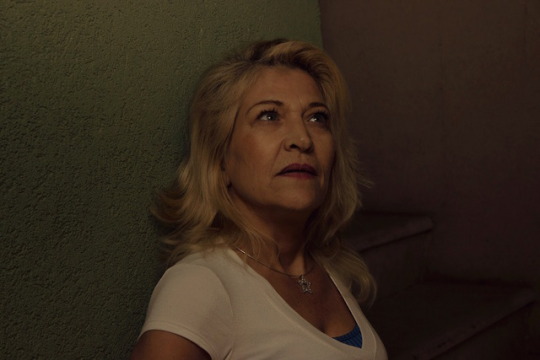
Focusing a New Lens on Mizrahiness
“Generation(s) of Levantines” by Leeor Ohayon
view the accompanying documentary photography series following the essay
“What exactly are you trying to capture? Which community? There just isn’t such a thing as Mizrahi,” my interviewee told me shortly. He had a point; what on earth was I trying to document?
Being of mixed Moroccan and Adeni heritage and having attended Jewish schools in London all my life, I became very much aware of the erasure of Mizrahi and Sephardic Judaism in the public realm. Jewish studies at school were conducted around an Ashkenazi-centric reading of history that began in Warsaw and ended with the Khurva synagogue in Jerusalem. Israeli Independence Day was celebrated with Klezmer music in the auditorium and dry falafel for lunch.
Mizrahi histories and cultures have been sacrificed at the altar of a collective Jewish imagination. That is to say-- our understanding of Judaism and Jewish memory is always conducted through the Ashkenazi experience, by Jews and non-Jews alike. The Ashkenazi label has become the default face of Judaism and Jewishness, and consequently is often found interchangeably replaced with just “Jewish.” Non-Ashkenazi cultures, in comparison, are hyphenated, asterisked, and put in boxes-- if not shelved entirely.
Perhaps that’s why heading to Israel to document Mizrahim proved to be my own Mizrahi education. I was confronted by the fact that my understanding, despite seeing myself as well versed in Mizrahi history, was coloured by my experience as a Mizrahi in the UK. Ashkenormativity alienates Mizrahim everywhere, but in Israel there is an entire political and social commentary surrounding this subject that often feels absent in the West.
When my interviewee asserted to me that there’s no such thing as “Mizrahi,” he was technically right. Mizrahiness is what professor Ella Shohat referred to as an “imagined community” borne of interactions with Ashkenazi Israel that ethnicised Mizrahi Jews.
So vast is the cultural, linguistic and geographic space that Mizrahi groups occupy that no single aspect could be said to be the unifying factor between them. Neither as followers of the Sephardic rite - Yemenite Jewry proving an exception to that - nor as hailing from a geographic East – for example in the case of North African Jews - and neither in a common lingua franca, like Yiddish for Ashkenazi Jewry.
Rather its formation merely owes itself to the fact that as Jews hailing from Islamic majority places, they endured a shared destiny as non-Ashkenazi Jews in an Ashkenazi state. They went from simply being Jews in their countries of origin to being Mizrahim in Israel.
There are many things to consider while photographing a subject as vast as Mizrahi identity. I had to account for the variation within it in my work, so I held many interviews across the country, with Mizrahim of all stars and stripes and all walks of life, in an attempt to better understand how to capture Mizrahiness.
When I asked my interviewees to point me towards what they considered as Mizrahi, I was told repeatedly to “go to the periphery”. The simple reason being that in the Israeli “periphery-” the localities of the north and south historical “frontiers” that lay outside the economically prosperous stretch of Israel’s central belt cities, I was to find “authentic” Mizrahiness like it “used to be.” Supposedly, unlike the residents of the Gush Dan metropolitan area, the inhabitants of this stretch of land were not altered by “modernity”.
In this assertion, the interviewees implied (perhaps unconsciously) that Mizrahi traditions and modernity could not be reconciled. The subtext was that to be “authentically” Mizrahi meant to exist outside of modern society. Aside from the fact that the quest for cultural authenticity is futile, many had used the same orientalist tropes that have historically been used to reduce Mizrahim to exotic folklore at odds with modernity.
Such a notion is as old as Zionism itself, which initially relegated historic Mizrahi and Sephardi communities in Eretz Yisrael outside of an Ashkenazi reading of history. A Jewish “return” to a “land without a people” was fundamentally an Ashkenazi return that refused to recognise that a society of Jews and non-Jews alike already existed in historic Palestine.
Likewise, the Ashkenazi establishment belief that Mizrahim were “primitive” and “backward” ultimately led to the disastrous housing policies of the 1950s and 1960s that forcibly placed Mizrahim across volatile front-line borders and empty desert expanses, on the basis that their supposed naturally “primitive state” could withstand living in such harsh conditions without modern comforts and standards.
Those spaces that Mizrahim settled in became the Israeli periphery of today, which remains etched into the minds of many, including those I interviewed, as spaces outside of modernity.
And yet there is something to be said for the “periphery” as a space that has protected Mizrahi identities and cultures. Particularly when the outskirts of Ashkenazi population centres are also taken into consideration- for instance, Tel Aviv’s southern districts or Jerusalem’s Musrara and Katamonim neighborhoods. These Mizrahi-majority areas served as incubators of a new ethnoreligious identity in Israel.
Mizrahi settlement in the ma’abarot (transit camps) and then in the moshavim (agricultural communes) and development towns that replaced them resulted in historic cultural and societal upheavals.
A break from the Mizrahi past in the diaspora was signaled on two levels, firstly, in Mizrahi settlers’ interactions with their new co-inhabitants that hailed from across the Muslim world; and secondly, in their interactions with the structures of Israel’s Ashkenazi-dominated bureaucracy- through its education system, the military, the employment service and so forth. These interactions took place against the backdrop of Mizrahi isolation from their countries of origin, given the lack of diplomatic ties between Israel and many Islamic and Arab states. The result of this discord is that successive generations of Mizrahim have been raised in a reality where their cultures have gone from being part of a two-millennia-old conversation with the broader region they inhabited to being relegated to the private spheres of home and synagogue within a culturally ‘western’ society.
It is precisely within these interactions with the state and against this backdrop of isolation that a new Mizrahi identity had begun to form on the margins of Israeli society. The subsequent result was an intra-Mizrahi conversation that has resulted in everything from a political consciousness to the birth of Mizrahit - a musical genre rooted in the experience of Mizrahi Jews in Israel.
One of the most apparent symbols of this cultural development is the modern Mizrahi attitude toward pre-wedding henna ceremonies: rituals that many interviewees had told me to avoid capturing for its lack of “authenticity” and as a worn cliché of Mizrahiness.
I shadowed henna planners and tagged along with them to wedding halls and synagogue basements across the country. Each time, I was greeted to a scene that evoked equal feelings of dismay and fascination. Hennas were conducted according to Moroccan cookie-cutter templates regardless of whether the participants were actually Moroccan or not.
I was told that the general gravitation toward the Moroccan tradition arose from the “fun costumes” and “lively atmosphere.” As the second largest Jewish ethnic group in Israel, Moroccans undoubtedly have left their mark on the nation’s collective cultural imagination. But the Moroccan way is also attractive, as one event planner pointed out to me, because many families want to host a henna ceremony but simply don’t know where to begin, as so many traditions were lost in the course of immigration and assimilation into Israeli society.
The modern resurgence of the henna ceremony owes itself to a growing movement of Mizrahi expression in Israel -- one that is increasingly vocal and unabashedly shameless. Yet it still reflects the literal Hebrew meaning of the word mizrah (east). It’s as though Mizrahiness is precisely just that - a smorgasbord of the East.
I witnessed a Moroccan-Yemeni couple split their ceremony in half allocating equal time to conduct a Moroccan henna and the Yemeni equivalent, a za’afa. I saw an Ashkenazi mother-in-law sitting in Moroccan dress at her Persian soon-to-be daughter-in-law’s henna, while the Persian grandmother sang in Farsi to the mixed crowd. I directed and photographed a henna photo shoot for a wedding magazine with sexed-up traditional dress. I witnessed things that can only be called pan-Mizrahi.
The act of carrying out a henna is perhaps one of the greatest testimonies to the perseverance of Mizrahi cultures and the simultaneous formation of something new. Hennas today pay tribute to a diasporic past that Israel’s founding fathers wanted forgotten in their quest for a Jewish Israeli national consciousness; they boldly pine for a different, newer Israeli identity, one better rooted in its geocultural neighbourhood.
In many ways, that pan-Mizrahi conversation is the closest resemblance to the vision of the unsung essayist, Jacqueline Kahanoff. Kahanoff was a French-educated Egyptian writer of Jewish Iraqi and Tunisian descent who proudly declared herself a Levantine when Israeli statesmen warned of the social and cultural “perils” that such an assertion could bring to Israeli society. In her essays, Kahanoff asserted that Israel should do its best to view waves of Jewish migration as an opportunity to formulate a new Levantine identity- one that emphasised integration with the region’s Arab communities. She named her philosophy Levantinism, and it is for her series of essays outlining this vision that this project is named.
While Kahanoff’s ideal has not necessarily come to fruition in Israel, a form of Levantinism has arguably manifested amongst Mizrahim.
On my journey, I also headed to a number of Israel’s heritage centres; small memorial-like independent museums that preserve the memory and traditions of Jewish communities from Aden to Kochi. A forty-minute bus ride from Tel Aviv takes you to the town of Or Yehuda, where both the Libyan Heritage Centre and the Babylonian Heritage Centre for Iraqis are found, separated only by a small stretch of road. The former, unlike the latter, is more austere and modest in appearance, but both heritage centres make an avid point of retrofitting Libyan and Iraqi Jewish histories within the Zionist narrative. Both heritage centres emphasised Jewish persecution under Arab Muslim rule and Mizrahi loyalty to the Zionist movement.
I was given a tour around the Libyan Heritage Centre by a guide who spoke of her own family’s suffering in the overlooked Libyan Holocaust. Few are aware that Libya, under Italian colonial rule, hosted the Giado concentration camp in which 562 Jews perished.
My guide relayed a real sense of frustration at Israeli society’s marginalisation of the Holocaust chapters that affected Jews in North Africa and the Balkans. “Why? Because we didn’t lose enough people?” she asked me.
Recognition of the Holocaust that blighted the Libyan community is a historical wrong that needs addressing. Its prevalence today is reflected in the fact that, in Israel, Holocaust remembrance has all the trappings of a civic religion. The memory of the Holocaust and the narrative of the Ashkenazi Zionist “pioneer” were core facets of Israeli identity building and the development of a collective national memory, and it is precisely due to the centrality of both such narratives in the Israeli national pantheon (at the expense of others) that Mizrahim have long felt shut out.
In the heritage center, as we toured countless rooms of wax figures clothed in regional Libyan dress, my guide reiterated the fundamental contribution of Libyan Jews to the Zionist movement, stopping by a series of black and white photographs to discuss Libyan involvement with Zionist youth groups. The role of Libyans in such groups was emphasized throughout the tour. Furthermore, the reiteration of Mizrahim as ardent Zionists was relayed to me in most of the heritage centres I visited and by many second-generation Mizrahim.
The centrality of the Ashkenazi “pioneer” to Israel’s founding story and the Mizrahi erasure within it have left successive generations of Mizrahim striving to be seen as equal partners in the Zionist project. It is that feeling of exclusion in particular, as many interviewees explained to me, that constitutes the origins of stereotypes like the Mizrahi vote for right-wing parties or the Mizrahi person who holds hawkish anti-Arab sentiments. The stereotypes echo the same historical processes that forced Mizrahim to prove themselves as loyal Israelis and to emphatically differentiate themselves from Arabs.
The desire to be written in as equals in the story of Israel’s founding is understandable; Mizrahim did partake in some of the most grueling aspects of state building. However, at the end of the day, the Zionist project was conceived as an Ashkenazi response to European antisemitism.
Devoid of the urgencies that Ashkenazi Jews faced in Europe, Zionism was unable to take root in the Arab world to the same effect. Members of the older generation, for the most part, were comfortable and secure in their homelands. In 1940s Iraq, for example, Zionist emissaries wrote of their despair in Iraqi Jews’ lacking resonance with Zionism. Zionism’s entrance into the Arab world was via the youth, offering Hebrew language classes and opportunities for the young to socialise, and even then only very modest numbers decided to immigrate as a result of Zionist ideals.
Rather, the reasons behind Mizrahi migration and flight are as complex as they are varied, taking place over a long period, from 1949-1979, continuing well into the 1990s. While state-sponsored discrimination was evident in Iraq in the late 1940s, it was the bombing of the Masuda Shemtov synagogue in 1951 - suspected by some to be the work of the Zionist underground - that truly propelled migration. In the case of the Moroccan Aliyot of the 1960s, Jewish emigration owed itself largely to the efforts of Zionist emissaries able to monopolise on the widespread uncertainty over the future following decolonisation and the Arab-Israeli conflicts, as well as genuine religious devotion. In Yemen, immigration owed itself to Messianic fervour and dire economic straits. And in some places, the reason for departure was explained to me as simply as “everyone was leaving, so we did as well.”
And yet the battle over Mizrahi memory continues. The same year of my arrival in Israel, the government declared the first Memorial Day for “the Departure and Expulsion of Jews from Arab countries and Iran” on November 30th. Mizrahi activists in Tel Aviv explained to me that such a holiday effectively rewrote history, asserting a single, rather than accurately pluralistic, narrative of Mizrahi flight and persecution. In doing so it pushes the idea of a “Jewish Nakba” which acts as a sinister counterweight to Palestinian displacement, while simultaneously asserting to Mizrahim that the key to being equal partners in Israel’s national memory is only through a narrative of eternal victimhood.
At the end of Passover, I headed to the Moroccan-majority development town of Yeruham to witness a “proper Mimouna.” I was enticed by the Moroccan pride I saw on display, moving between houses where front doors were left open for people to come and join. I was able to witness the essence of a Mimouna I thought lost in Israel’s big cities, warmed by the genuine hospitality of open doors that could only stay unlocked in a trusting environment.
The desert air and the individuals I met left me with a feeling that I had to return and spend a lengthier period in Yeruham. And so I did. I quit my part-time job, packed my bag, and headed down south in a move that baffled many people around me as I followed those endless cries:
“Go to the periphery.”
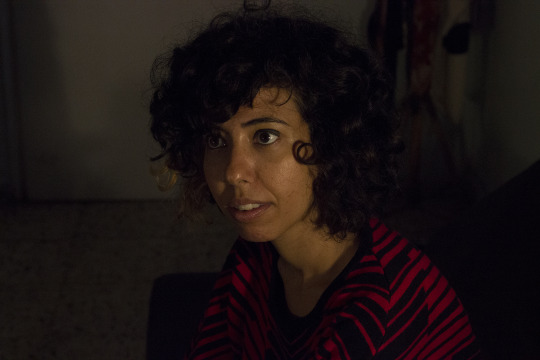
Adi Keissar, poet and founder of Ars Poetika, a Mizrahi and female-friendly poetic space in a field traditionally dominated by Ashkenazi men. Kerem-ha-Teimanim, Tel Aviv, 2015.
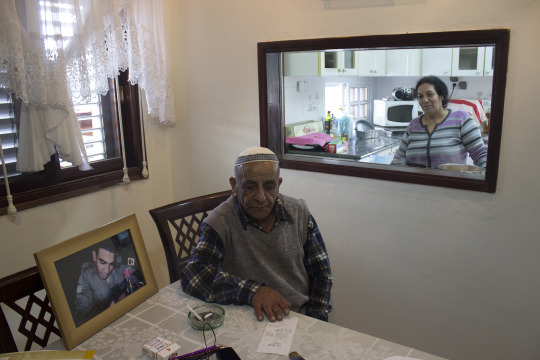
Interviewees in a Moshav Yinon, a Yemenite-majority agricultural village in central Israel, 2015.
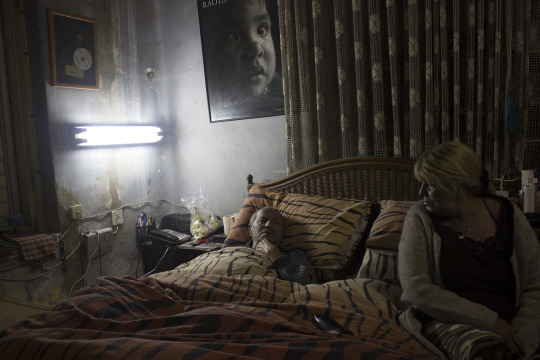
My great-uncle Moshe Meshumar. He was part of the Shubelim band, one of the earliest players in the formation of Mizrahit music, a genre that combined electric guitars with Arabic, Turkish, Greek and Yemenite elements sung in Hebrew.��Shabazi, Tel Aviv, 2015.
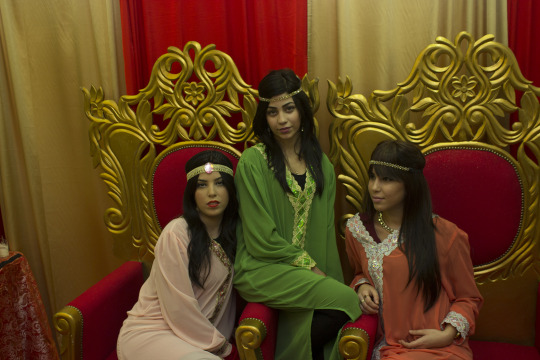
Girls dressed up at a Moroccan henna ceremony. East Jerusalem, 2014.
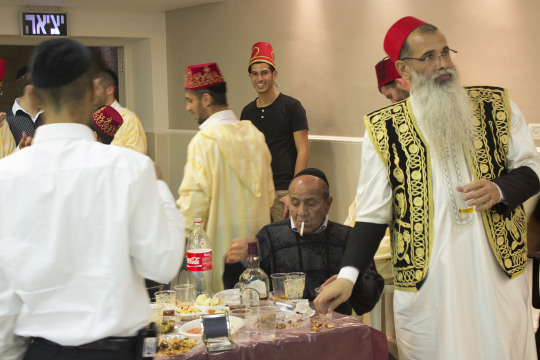
A Moroccan pre-wedding henna ceremony. East Jerusalem, 2014.
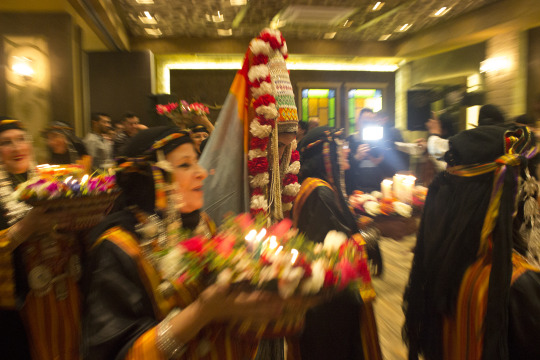
A bride wears the Tishbakh lulu (originally of the Sana'a region) and is accompanied to the hall for her pre-wedding za'afa, a ceremony comparable to the Moroccan henna. Binyamina, 2015.
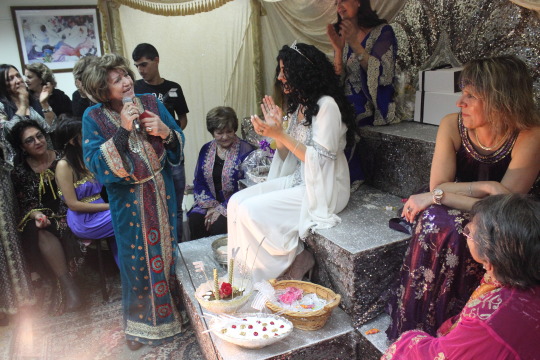
A bride's grandmother sings to her at a Persian henna celebration. Rishon Le Zion, 2015.
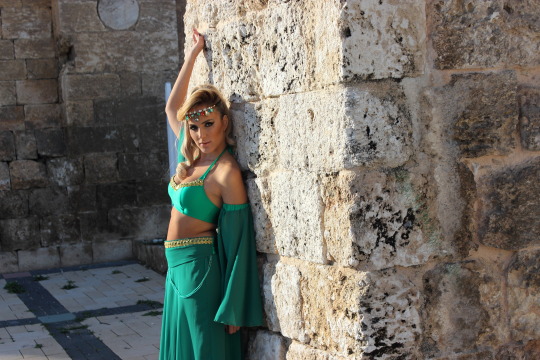
A photoshoot for a henna fashion magazine. Ramla, 2015.
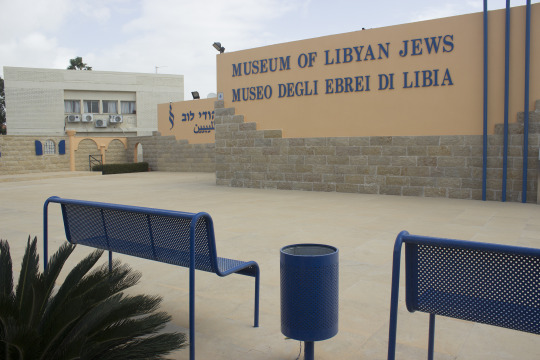
Libyan Heritage Centre, Or Yehuda, 2015.
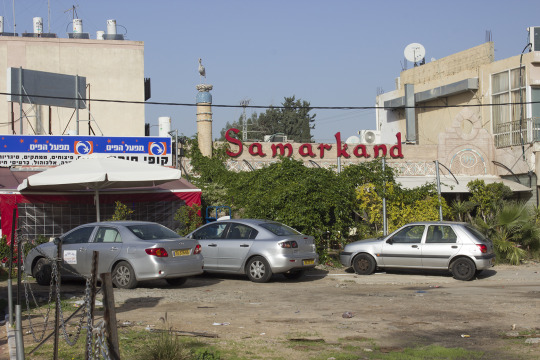
Or Yehuda, 2015.

Ohel Moshe Yemenite syangogue, Moshav Yinon, 2015.
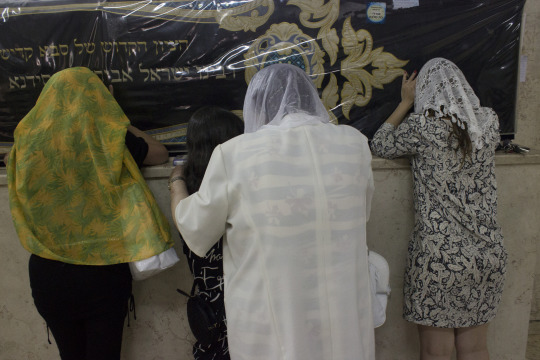
Women pray at the Baba Saleh Tomb. Netivot, 2016.
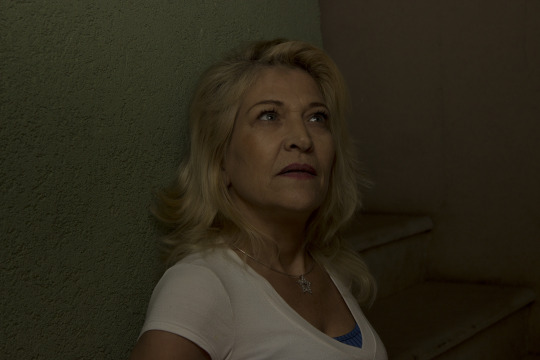
Beit Shemesh, 2014.

The shouk remains the domain of blue-collar Mizrahim and Palestinians. Carmel Market, Tel Aviv, 2015.
9 notes
·
View notes
Text
Shirin Neshat on Her Path from Art School Outcast to Contemporary Art Icon
Art history is filled with stereotypes of artists that mostly sit at the extremes—the starving artist who can barely afford her or his paints, and the artistic genius whose body of work goes on to influence generations to come. The stories of what happens along the many stages of an artist’s career in between those extremes is too often glossed over. In this new series, we hope to change that by getting the stories behind the rise of some of contemporary art’s greats, hearing the struggles and ultimate triumphs that led them to change art as we know it.
Iranian artist Shirin Neshat, 61, is perhaps an unusual place to start this series: After graduating from art school in 1982, she gave up. Yet despite abandoning artmaking for 10 years, and working at an arts nonprofit in New York City, she eventually returned to Iran and to her art practice. She soon generated a career-making aesthetic: Since 1993, she’s created black-and-white films and photographs that examine political conflict and Muslim culture via a feminist lens.

Shirin Neshat, I Am Its Secret, 1993. © Shirin Neshat. Photo by Plauto. Courtesy of the artist and Gladstone Gallery, New York and Brussels.

Shirin Neshat, Allegiance with Wakefulness, 1994. © Shirin Neshat. Photo by Cynthia Preston. Courtesy of the artist and Gladstone Gallery, New York and Brussels.
Her most famous photographic series, “Women of Allah” (1994), features images of the artist’s body overlaid with Arabic text. A gun appears in many of the images, poking out from between Neshat’s feet or lying over her forearms. More than 20 years after their creation, the pictures remain jarring critiques of violence and traditional gender roles.
Neshat’s 1998 film Turbulent features a split screen with a man singing in front of an audience on one panel, and a woman standing alone on the other, addressing Iran’s prohibition of women singing in public. It won the Venice Biennale’s Golden Lion—among contemporary art’s highest honors.
Neshat is represented by Gladstone Gallery (New York, Brussels) and Goodman Gallery (South Africa), and has exhibited around the globe at major institutions such as the GEM museum of contemporary art in the Netherlands, the British Museum, and the Hirshhorn Museum and Sculpture Garden in Washington, D.C. She has received awards from the Rockefeller Foundation, the Venice Film Festival, and the World Economic Forum. This October, the Broad Museum in Los Angeles will open a major survey of Neshat’s work.
But before she was successful, Neshat reveals below, she was just an art-school outcast.
How did you become interested in art? Were there any artworks or artists that were particularly influential?
It’s a funny story. You know, I come from Iran. I lived in a very small, religious, conservative town, Qazvin. I was never really exposed to art as a child. No one in my family was artistic. We didn’t visit museums. Art was considered decoration or craft. It was a foreign idea to become an artist in the way we understand it today. Still, I developed an interest in becoming an “artist”—more romantically so. I never understood this tendency. But ever since I was seven or eight years old, everyone called me an artist because I did drawings at school.
I occasionally went to Tehran, where there were pockets of cultural activities, but I didn’t know anything about it. I did have a lot of interest in literature. In Iran, we studied poetry. We read a lot. That eventually became a part of my artwork, when I started writing on photographs.

Shirin Neshat (left) at Berkeley circa 1979. Courtesy of the artist and Gladstone Gallery, New York and Brussels.
My art education really began when I came to the U.S. for my last year of high school, when I was 17. I went to UC Berkeley, where I studied art. Before that, it was just this blank. So it’s hard for me to talk about the artists who influenced me, because I didn’t have that until I was in my early twenties.

Diego on my mind (Self-portrait as Tehuana), 1943. Frida Kahlo Art Gallery of New South Wales

No title , 1964. Eva Hesse "Big Picture: Art After 1945" at Seattle Art Museum, Seattle

Judy Chicago Designing the Entry Banners for “The Dinner Party,”, 1978. Judy Chicago Brooklyn Museum
In Berkeley, out of all the artists we studied from Western culture, I remember gravitating toward Frida Kahlo. To this day, I find her fascinating—who she was as a woman and a political figure. Her relationship to Diego. Her style, which became an extension of her artwork. I was more drawn to women artists for sure. I remember being really taken by Eva Hesse, her minimalism and the way she died. I was really saddened by her story when I was in school. I remember Judy Chicago was doing a lot of things that many other women students and I were following. To this day, I’m drawn to women artists who have had interesting, sometimes tragic lives. I’ve even made films about them—Women Without Men (2009), for example, was based on a novel by a woman (Shahrnush Parsipur) who was imprisoned for many years.
Tell me about your first attempts to make art.
In my classes in Iran, the teachers used to ask me to do murals on the blackboard or the walls. There was another strange thing, too: I used to draw women and then design clothes for them. I’d dress them up in certain ways. My cousin told me recently that when I left Iran, she took my book of my drawings. I don’t know what that was about, but I had this fascination with women and dressing them up. My cousin still has that book and I haven’t seen it for 40 years. Maybe I was influenced by magazines—fashion, modernity. As I discovered my own body, I became fascinated (along with the rest of my generation) with a Western look we saw in the movies, television shows, and publications. Gone with the Wind was massively popular in Iran. We watched Peyton Place and The Flying Nun. We were just mesmerized by Hollywood.

Shirin Neshat, Soliloquy Series, 1999. © Shirin Neshat. Courtesy of the artist and Gladstone Gallery, New York and Brussels.
At UC Berkeley, I was totally lost. I immediately realized that my idea of art and being an artist was stupidly romantic. In order to be an artist, you have to have ideas that are more than intuitive. You have to know what you have to say. For the first several years of school, I was trying to come up with ideas that bridged my Persian and Islamic heritage with what I was learning about Western art. That’s so typical of non-Western artists who study at Western schools: trying to build an identity by building a bridge. I was making paintings, prints, and works on paper with Persian iconography. Lots of surrealistic shapes and female figures (which, ironically, eventually resurfaced in my more recent art practice). I don’t think the other students felt they could tap into what I was making.
It was really terrible—I destroyed evidence of all this work. Honestly, I had to be one of the weakest artists at the school.I applied to Berkeley’s graduate program, and my professor told me that I just barely got in.

Shirin Neshat with one of her paintings circa 1980s. Courtesy of the artist and Gladstone Gallery, New York and Brussels.
While I was at Berkeley, there was the Iranian Revolution. Horrific things were going on in my life—I lost my immigration status, couldn’t go home anymore, and was separated from my family. My studies took a backseat. I wasn’t blossoming like some of the other students. After I graduated, I didn’t make art for 10 years. I thought, “Okay, you’re not a good artist, move on with your life.”
“I destroyed evidence of all this work. Honestly, I had to be one of the weakest artists at the school.”
When I moved to New York, I did show slides of my work to some prominent galleries. They were charmed by me as a person, but when they saw my art, they looked at me like, “You must be joking.” One gallerist, though, wanted to have coffee with me. I felt embarrassed. It was horrible, and I thought, “I’ll never do this again.” Instead, I worked at the Storefront for Art and Architecture. I was the co-director with my ex-husband, Kyong Park, who founded it. We worked together for 10 years, cultivating this grassroots, not-for-profit organization. We made exhibitions, conferences, panels, and publications. I interacted with artists and architects such as Vito Acconci, Mel Chin, Mary Miss, Kiki Smith, Zaha Hadid, Jean Nouvel, Judith Barry, and Alfredo Jaar. My true art education came from Storefront.
What encouraged you to get back into art?

Shirin Neshat in front of the exhibition space, Storefront, in downtown Manhattan circa 1980s. Courtesy of the artist and Gladstone Gallery, New York and Brussels.

Shirin Neshat, Untitled, 1996. © Shirin Neshat. Photo by Larry Barns. Courtesy of the artist and Gladstone Gallery, New York and Brussels.
There was no diplomatic relationship between the U.S. and Iran for a long time. I feared that if I went back home, I wouldn’t be able to return to the states. Finally, after about 11 years, I got my American citizenship and felt confident enough to make the trip. Those travels were very moving and shocking. When I came back, I felt an urge to make something that kept this relationship alive again between me and Iran. But I knew that I needed time and space to make something.
I applied for this residency at Henry Street Settlement—and I got it. I had a son by that time. I’d leave Storefront two days a week and think about my experience in Iran and ideas for artmaking. At first, I was making drawings of my hands and writing on them. Then I thought, “Wait a minute, I should photograph them.” Slowly, with the help of my photographer friend Plauto, I started to take photographs of myself: my hands, my feet, everything that’s allowed to be shown in Iranian culture. I began to write on Xeroxes of the pictures—lines from the poetry I’d brought back from Iran. It was totally playful. I had no goal of showing the work. These were from my “Unveiling” series, which became part of “Women of Allah.”
“Playing a role, being a performer, I was the master of my own ceremony. I was in control. I felt like, ‘this is me.’”
Then this exhibition space called Franklin Furnace, which was run by the artist Martha Wilson, was asking for proposals. I made up this statement for a show devoted to the female body and literature. They called me and said, “You have a one-person show for next spring.” That became the impetus for me to crystallize my ideas. I showed my photographs and a Super 8 film. This was in 1993. That was my absolute first body of work. I was in my thirties.
I remember Kiki Smith came, bought one of my works, and gave me some good advice. She told me that the way I was making the pictures, writing on Xeroxes, they’d be ruined. She advised me to use photographs. I realized I wasn’t thinking about the long term. I started to teach myself photography.

Shirin Neshat, Fervor (film still), 2000. Photo by Larry Barns. © Shirin Neshat. Courtesy of the artist and Gladstone Gallery, New York and Brussels.

Shirin Neshat, Offered Eyes, 1993. © Shirin Neshat. Photo by Plauto. Courtesy of the artist and Gladstone Gallery, New York and Brussels.
When I made the show at Franklin Furnace, I put everything out there. I felt such a passion for what I was doing. Without any plan to be successful or have a career, I just purely desired to make art. My ideas were unstoppable, shaping naturally. I realized I had this aesthetic that was minimal, highly stylized, poetic, and layered with meaning. Using my body. Playing a role, being a performer, I was the master of my own ceremony. I was in control. I felt like, “This is me.”
Were there early instructors or mentors that really encouraged you?
UC Berkeley, when I was there, was known for these super-macho male teachers who taught a lot of sculpture. Like Frank Stella. But there were two particular teachers I remember.
Harold Parris was an extremely poetic, sensitive artist. Easy-going, non-macho. He let us come to his studio—he really opened up to the students. And Silvia Lark, who taught me printmaking. She was native Indian and later died from cancer. A very tragic life. I was attached to her, and that devastated me.
I gravitated toward instructors who were female or had a more feminine touch. School was not a complete failure. It was just the political climate, and my English wasn’t good. I was a bit of an outcast and didn’t relate very well to other students.
How did Iranian culture or cultural expectations affect your desire to be an artist?

Shirin Neshat, Rapture (still), 1999. © Shirin Neshat. Photo by Larry Barns. Courtesy of Galerie Jérôme de Noirmont, Paris.
I always felt like if I wasn’t a visual artist, I would have been a poet. Someone who lived in her imagination. I think about living in Iran, in conservative villages and political environments. We relied on literature. That’s where you could find a lot of freedom of expression. Emotionally, I was always a dreamer.
When I came alone to this country, there was a lot of sadness in being isolated, in exile. My best friend was my imagination. I couldn’t completely relate to the American dream or the Iranian community here. In my art, I could create a universe where I felt at home. The New York underground art scene became my haven, what allowed me to persevere.
What were the biggest obstacles to becoming an artist?

Sherin Neshat (right) with a film extra while shooting Rapture circa 2000. Courtesy of the artist and Gladstone Gallery, New York and Brussels.
Finding an identity. I’m very glad I left art when I did. There’s nothing worse than mediocrity. Many of us go to school, and we’re content even if the work isn’t great. I needed to find what I had to say, what people should pay attention to. What makes good art? What do I want to communicate? I figured this out after my experience in Iran.
“Eventually, I made a little money from my artwork, and I couldn’t believe that I had a little bit of luxury. Struggling was an important experience for me.”
I became obsessed with understanding the Islamic Revolution, what had transpired in the country, and how women fit in. I took it upon myself to make a grand project of exploring militant women who were faithful to the revolution and fundamentalism. I was like a person who wants to write a book, then finds a premise. I just created a body of work that raised questions. It was like a sociological study, looking at interesting, contradictory viewpoints.
I never thought of art as a career and a way to make money. At Storefront, we never made any money. My husband and I were the only staff members, and we and our son were living hand to mouth on a shoestring budget. Sometimes there was a struggle to pay bills. I gave up a job at a textile company, making stupid things, for living this way—on the edge, making something out of nothing. Art was an extension of life: a set of questions and circumstances that you experience. We struggled in New York, but we lived richly, meeting the most fantastic artists and architects. Eventually, I made a little money from my artwork, and I couldn’t believe that I had a little bit of luxury. Struggling was an important experience for me.
What would you consider your breakthrough work?

Turbulent, 1998. Shirin Neshat MCA Chicago

Turbulent, 1998. Shirin Neshat MCA Chicago
I started making “Women of Allah” in 1994. The series became somewhat known. But I think my breakthrough was the video Turbulent (1998), really. That was at the Venice Biennale in 1999. It got the Golden Lion Prize. What happened was that once people discovered the film, they started to recognize my photographs. I became known as a video artist, and people forgot I was a photographer.

Shirin Neshat (center, left) at the opening of her exhibition “Turbulent” at the Whitney Museum in 1998.
The inspiration for Turbulent is a funny story. I was in Istanbul one day, and I saw this young blind woman singing on the street. It was so powerful—this beautiful, guttural voice not intended to please any audience. Yet there were mobs of people surrounding her. I wanted to make a counterpart. In New York, I met my current husband, Shoja Azari. He’s a filmmaker. He ended up being the singer in my film. The piece changed our lives—it turned into an incredible romance.
How did you deal with any rejections you faced early on?
My first serious gallery exhibition was with Annina Nosei (in New York) in 1995. I showed “Women of Allah.” People paid attention because it was strange work. They were completely puzzled by it and taken aback. There was a writer at the New York Times who was particularly confused: Was it sensationalizing violence, or making fundamentalism radical chic? Was I being controversial for the sake of being controversial? What’s the point? Even Iranians wondered if I was supporting the government.

Shirin Neshat, Rebellious Silence, 1994. © Shirin Neshat. Photo by Cynthia Preston. Courtesy of the artist and Gladstone Gallery, New York and Brussels.

Shirin Neshat, Speechless, 1996. © Shirin Neshat. Courtesy of the artist and Gladstone Gallery, New York and Brussels.
I was just asking questions, questioning martyrdom. I was excited by the fact I was getting a reaction, but I did feel rejected in some ways. I wasn’t sure whether my career would continue, but I think the work raised a lot of eyebrows. While it was controversial, it was also praised. A lot of people wanted to buy it—and show it. By 1997, I felt like a tailor, making editions of my “Women of Allah” works. It was boring! I decided to make video. I rebelled against my own successful signature. But to this day, my “Woman of Allah” photographs are my most popular images.
from Artsy News
0 notes
Text
The alt-right manifesto that has Trumpworld talking
New Post has been published on https://thebiafrastar.com/the-alt-right-manifesto-that-has-trumpworld-talking/
The alt-right manifesto that has Trumpworld talking
An alt-right supporter marches in Portland, Oregon. | Karen Ducey/Getty Images
politics
An anonymous book author has lit the online right on fire — including some in the president’s orbit.
The most important political book of the past year just might be a grammatically challenged manifesto in favor of nude sunbathing written under the pen name Bronze Age Pervert.
Where Ayn Rand’s “Atlas Shrugged” inspired generations of libertarians to enter politics, and Aaron Sorkin’s “The West Wing” did the same for idealistic liberals, a cohort of young, right-wing men are today gravitating toward “Bronze Age Mindset.” The self-published book urges them to join the armed forces in preparation for the onset of military rule.
Story Continued Below
Since its publication in June 2018, the book has gained a following online, and its author, known to his fans as BAP for short, has come to the attention of notable figures on the Trumpist right. Earlier this month, the book was the subject of a 5,000-word review by Michael Anton, a conservative intellectual who served as a spokesman for Donald Trump’s National Security Council. Anton concludes by warning, “In the spiritual war for the hearts and minds of the disaffected youth on the right, conservatism is losing. BAP-ism is winning.”
Anton is just one of the Trump world figures who has taken notice. “It’s still a cult book,” said another former Trump White House official. “If you’re a young person, intelligent, adjacent in some way to the right, it’s very likely you would have heard of it.”
Right-wing agitator Mike Cernovich said he knows of young staffers in the White House who are fans of Bronze Age Pervert’s Twitter account — where the author posts photos of buff, shirtless men and promotes far-right positions on the culture war — though he does not know if they have read the book.
The 200-page book mixes Nietzschean philosophy with critiques of contemporary Western society, denigrating homosexuality, Judiasm, Islam, feminism and much else along the way. “Inside every noble Greek was an unquenchable lust for power,” is one fairly typical statement. “Modern world not bad just because modern,” is another, displaying the author’s habit of lapsing into broken English by dropping articles. The book claims that the leaders of the European Union have “tiny moleman eyes.” Many of its passages are profane and unprintable.
The book’s ascendance in online, far-right circles is indicative of the latest phase of the culture war that has fueled Trump’s presidency.
Most of the well-known figures associated with the alt-right or “alt-lite” — Milo Yiannopoulos, Gavin McInnes, Richard Spencer — have been successfully demoralized, deplatformed or otherwise banished from the public square. But this has not eliminated the underlying source of their relevance: disaffected young men, mostly white, with internet access.
In large part, what’s left in the online spaces they inhabit are pseudonymous figures like Bronze Age Pervert, whose output tends to be more intellectualized, even esoteric.
While the loose alt-right network that became infamous in 2016 was filled with attention-seeking provocateurs who cheered on Trump’s rise, the new voices in this space are alienated and ambivalent about Trump. And far from being inspired by his signature call to “Make America Great Again,” their view of contemporary American society is decidedly dystopian.
Bronze Age Pervert is active on Twitter in a network of similar, pseudonymous accounts with names like Just Loki and 17thCenturyShytePost that revel in mythic, aristocratic pasts while trafficking in racism and anti-Semitism.
The memes — catchy ideas and images that are widely shared online — produced in such far-right internet circles, such as Pepe the Frog, regularly intrude on mainstream political discourse, sometimes even getting adopted by Trump himself. And the current fixations of these figures offer a glimpse of the concepts gaining traction there.
Figures in this space frequently refer to their belief that elite media is preparing Americans for a future in which their quality of life is greatly diminished and they are reduced to eating insects for protein.
“What is up with all these ‘we need to learn to eat cockroaches and maybe each other haha’ articles,” tweeted Just Loki on Wednesday, linking to a Newsweek article referencing cannibalism. “Perfect beer food—wash down your meal worms with a nice IPA!” tweeted 17thCenturyShytePost sarcastically in response to another article about eating insects earlier this month.
And because this corner of the internet fixates on population genetics and has a high affinity for Slavic and northern European cultures, there is a fascination with the Udmurt people, a small ethnic group that lives mostly in Russia, and the fact that a high proportion of its members have red hair.
The accounts also oppose mass migration, echoing the themes of the “Great Replacement” conspiracy theory invoked by the gunman who perpetrated the Christchurch, New Zealand, massacre, and apparently again by the El Paso shooter. The idea, articulated in a 2011 book by the French writer Renaud Camus, claims that European elites are secretly conspiring to replace their countries’ white majorities with immigrants from Africa and the Middle East.
In his book, Bronze Age Pervert describes Western societies as ruled by “bug men” and “lords of lies,” urging readers to pursue a life of “sun and steel” — that is, tanning and weightlifting.
Across 77 chapters of cryptic musing, the book describes social justice as “disgusting parasitism,” opines that women who succeed in traditionally male domains are “spiritual lesbians,” and complains that the U.S. intelligence services employ too many Mormons.
Anton, in his review, earnestly reckons with the book’s critique of Charles Darwin and notes that at one point it cracked the top 150 bestsellers on Amazon. Anton writes that the book was given to him by Curtis Yarvin, an internet philosopher who writes under the name Mencius Moldbug, favors a return to monarchy and reportedly communicated with Steve Bannon through an intermediary while Bannon was in the White House.
After encountering the book’s intentional spelling and grammar mistakes, Anton gave up on it until former White House speechwriter Darren Beattie urged him to read it in its entirety. Beattie was fired from Trump’s White House last year after it was revealed he spoke at a 2016 conference attended by Peter Brimelow, whom the Southern Poverty Law Center describes as a white nationalist. Beattie, who denounced the firing as guilt-by-association, now works as a speechwriter for Republican Rep. Matt Gaetz of Florida, a close ally of Trump’s in the House.
Much like the Trump phenomenon itself, it can be difficult to tell where to place “Bronze Age Mindset” along the spectrum between elaborate joke and deadly serious. Reached via direct message on Twitter, Bronze Age Pervert, declined to discuss his real-world identity. In a rambling note, said he was influenced by a book about homosexuality in the Nazi army and claimed, “I’m largely responsible for the Trump administration’s push for universal worldwide sodomy promotion,” an apparent reference to the administration’s campaign to abolish laws that criminalize homosexuality. (This appears to be a joke. A source close to the White House who is familiar with the initiative scoffed at the claim.)
Satirical nonsense aside, events such as recent mass shootings inspired by far right ideas, as well as acts of violence by believers in the fantastical QAnon conspiracy theory, underscore the gravity of this corner of internet culture.
“There’s a whole generation of younger guys who are reading this and buying into this, but there aren’t a lot of paths to channel that constructively,” said one organizer on the Trumpist right, who declined to be named in an article that contained the term “alt-right.”
“Insofar as people are worried about radicalization on the right towards violence, one of the things I worry about is this generation of younger guys are going to conclude there’s no space for them or their voice in the political process, and the only way they can express themselves is in these ugly, corrosive ways,” the organizer said. “In my opinion, the way to help these people is not to turn them 180 degrees, but to turn them 15 degrees.”
Read More
0 notes